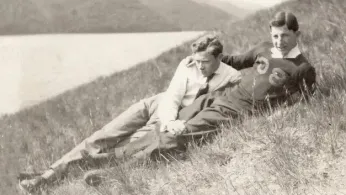
4 hours ago
‘Loving II’: Hugh Nini and Neal Treadwell’s New Photobook Illuminates Hidden Histories of Men in Love
READ TIME: 3 MIN.
When Hugh Nini and Neal Treadwell published their first photobook, "Loving: A Photographic History of Men in Love, 1850s–1950s", they opened a window onto a hidden world: hundreds of vernacular photographs capturing men in loving, romantic contexts, spanning over a century and sourced from across the globe. Now, with the release of "Loving II: More Photographic History of Men in Love, 1850s–1950s", Nini and Treadwell deepen and expand this archival project, bringing even more rare images—and the stories they represent—into public view .
The journey began in 2000, when, after a routine Sunday visit to a Dallas antique shop, Treadwell discovered a photograph from 1927 showing two men in a tender embrace . At the time, both men assumed this was a singular piece of lost history. But as they continued to browse flea markets, estate sales, and online auctions, more photographs emerged—eventually forming a collection now numbering over 4,000 images, sourced from 36 countries and spanning formats from daguerreotypes and glass negatives to photo booth strips .
According to the authors, many of these photographs were taken at considerable personal risk, in an era where same-sex love was often criminalized or forced into secrecy. Yet, the images reveal not only courage but also the universality and persistence of love, even in the face of adversity .
"Loving" found global resonance, published in five languages and featured in media outlets across at least 27 countries . Its images, selected for their unmistakable intimacy—often a glance, a gentle touch, or coded inscriptions—challenged assumptions about LGBTQ+ invisibility prior to modern legal reforms. The book became a touchstone in LGBTQ+ history, countering narratives of erasure and bringing to light personal stories lost to mainstream history.
With "Loving II", Nini and Treadwell continue this work. The new volume presents hundreds of additional photographs, many never before published, further illustrating the diversity of experience and expression among men in love. The authors’ curatorial sensibility remains: images are chosen for their emotional authenticity and historical significance, offering nuanced perspectives on intimacy, resilience, and joy .
The significance of "Loving II" extends beyond nostalgia or curiosity. For many LGBTQ+ people, representation in historical archives has long been limited or distorted. The photographs included in Nini and Treadwell’s books disrupt assumptions about the past, revealing that same-sex love has always existed, even if it was not always public or legally recognized .
The images span continents and cultures—Australia, Bulgaria, Canada, France, Japan, Russia, the United States, and more—demonstrating the global reach of queer lives and loves . The photographs, which range from formal portraits to casual snapshots, were often preserved in secret, hidden in shoe boxes or passed down through families. Some even contain coded notes or inscriptions, offering further insight into the strategies people used to claim, record, and protect their relationships .
For Nini and Treadwell, the act of collecting, preserving, and publishing these images is a form of activism—a way to ensure that the history of LGBTQ+ people is not lost or erased. As Treadwell notes, “Our goal is to continue to have museum exhibitions wherever we can that will propel us into telling this story and sharing the history that love is love. Love has been around forever” .
The release of "Loving II" has been met with critical acclaim across LGBTQ+ media and broader cultural circles, with reviewers highlighting both the artistry of the photographs and the importance of reclaiming lost histories . Exhibitions featuring selections from the Nini-Treadwell collection have been held internationally, including recent museum shows in Switzerland, bringing these stories to wider audiences .
The impact of the books is felt not only among older generations, who may see their own lives reflected in the pages, but also among younger LGBTQ+ people, for whom these images offer a sense of continuity and belonging. As one reviewer observed, “Looking into the past of same-sex couples allows us to see them in our present and even into our future as a blooming community” .
"Loving II" stands as both a scholarly resource and a poignant reminder: love endures, even against the odds. Through their careful curation, Hugh Nini and Neal Treadwell illuminate the hidden histories of men in love, creating a vital archive that challenges erasure and affirms the universality of love across time and place. Their work is a testament to the resilience of LGBTQ+ people and the importance of preserving our collective past for future generations .






